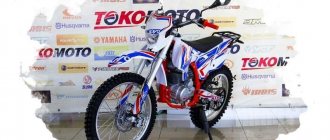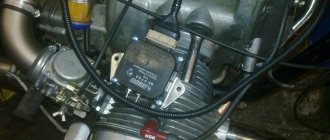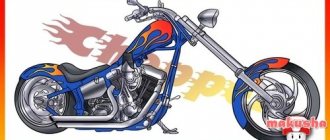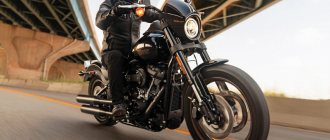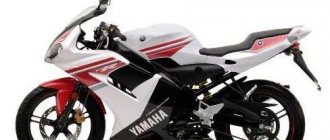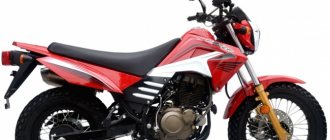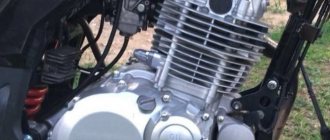Chopper club
A year ago, when choosing my first motorcycle, I came across the original of this article in English. To make it easier for the iron brothers to find a new horse in the off-season, I decided to transfer and post it. Even though it is not new, it is quite relevant for our market - cruisers have been produced for a long time and have a long life. Enjoy reading, don’t forget to put “+” at least for the volume 
We took 11 big V-twins and put them through a variety of operating conditions. Based on the results of the test, it became clear that not only Harley-Davidson produces decent devices on the market of such motorcycles.
One day, even though we were from southern California, we remembered what winter was like. Our white-toothed smiles froze like stones on our faces, where the only sign of life remained wild eyes. We often pulled over to the side of the road because the cold was too much for us. Although in fact, this four-day test of large twins - with rain, frost, hail, wind, snow and other delights of life, showed us what ordinary Americans encounter every day near their garage doors. Our guest tester from Rhode Island had every reason to laugh at us.
That being said, the bikes were undeniably hot – 11 beauties, the most coveted big twins; Before us, not a single magazine organized a simultaneous test drive of so many devices of this class. We previously addressed the topic of large twins in August 2000, and a lot of water has passed under the bridge since then. At that time, the first prize went to the Yamaha Road Star, but a bunch of other contenders appeared on the doorstep. The following models were selected for the test ( approx. transl.
- prices in the USA for 2002, here these devices from 2004-2006 cost almost the same, plus or minus a kilometer due to mileage and tuning): - HD FXDX Dyna Glide Sport ($13,995 - $14,745) - HD Softail Deuce ( 16555 - $17840) - Honda VTX 1800 Retro ($13000-13500) - Kawasaki Vulcan 1500 Classic FI ($10600) - Kawasaki Drifter ($11800) - Kawasaki Mean Streak ($11000) - Suzuki Intruder 1400 ($8349) - Suzuki Intruder 1500LC ($10,000) - Victory V92C ($13,700-14,300) - Yamaha Road Star 1600 ($11,000-11,200) - Yamaha Road Star Warrior XV1700PC ($12,000) The selection criterion was simple: cruisers with a V-twin displacement of more than 1200 cm3 (which is why the HD V-Rod didn't make it to this test).
Our test drivers were as different as the bikes. We specifically selected people of different builds and sizes in order to collect detailed reviews about the ergonomics of each device. Our smallest rider, Cobra Engeneering's Blaine Burchfield, is 165cm/79kg, with our biggest reader Paul Berry from Rhode Island at 195cm/131kg. The rest of the test participants: - Editor Andrew Cherney, 170cm/67kg - Editor Jamie Elwidge, 177cm/61kg - Rhonda Hoffman, Planet Cruiser, 172cm/did not say - Doug Mayer, Muzzy, 177cm/83kg - Our fan Paul Posey from Georgia, 177cm/ 88kg - Greg White, producer of our TV show on the Speed Channel, 189cm/93kg
We specifically selected people of different builds and sizes in order to collect detailed reviews about the ergonomics of each device. Our smallest rider, Cobra Engeneering's Blaine Burchfield, is 165cm/79kg, with our biggest reader Paul Berry from Rhode Island at 195cm/131kg. The rest of the test participants: - Editor Andrew Cherney, 170cm/67kg - Editor Jamie Elwidge, 177cm/61kg - Rhonda Hoffman, Planet Cruiser, 172cm/did not say - Doug Mayer, Muzzy, 177cm/83kg - Our fan Paul Posey from Georgia, 177cm/ 88kg - Greg White, producer of our TV show on the Speed Channel, 189cm/93kg
California's Death Valley, located 200 miles from our office in Los Angeles, was chosen for a test drive. Although this place is probably the hottest in the Western Hemisphere, it was -2C the night we arrived.
First impression
Of course, cruisers are chosen not only for appearance, but this factor remains a key one. The first thing that caught our eye at the beginning of the test was how diverse our test subjects looked. The addition of the word "power" to the word "cruiser" greatly changed the design of these vehicles, and today, when purchasing, you can choose between a classic and a more modern, often aggressive, style.
The Honda VTX 1800 Retro is as hard to miss as a bulldozer in a sandbox. Almost none of our riders appreciated this damn long locomotive with giant wings that add to its already considerable weight. Those who like this “a la Indian” style will also not ignore the Kawasaki 1500 Drifter. Our guys thought that the Drifter's design was the standard retro, in contrast to the kitsch of the VTX. The Suzuki 1400 was designed so long ago that it looks like a classic at first glance. Its lines appeal to fans of the classic chopper style - see how the frame encloses the engine, how the details are designed and adjusted to hide nondescript elements of the design. This motorcycle can be viewed in different ways, but it certainly deserves attention.
Let's move on to classic cruisers
These motorcycles look like they were made in the middle of the last century, but using modern technologies. This class includes HD FXDX, Kawasaki Vulcan Classic, Suziki 1500LC, Yamaha Road Star and Victory V92C. In terms of design, the majority of votes went to Vulcan. Many also liked the Road Star, especially its very stylish engine, but the general consensus was that it would need a fair bit of work to match the Vulcan's looks. The Victory design has caused the most controversy - its cylinders are painfully “skinny”, but some people think that it should be so. In general, the quality of its finish evokes positive emotions and is close to metric cruisers, despite some annoying flaws (for example, a loose ignition switch cover). With its flat black belt and exhaust, the HD FXDX was more to look at than to drive. But despite this, we cannot call it the most beautiful. The vague design of the Suzuki 1500LC has again been criticized, despite new wheels and more stylish turn signals. However, many of its owners like it anyway. The three street rods presented for testing (Warrior, Deuce, Mean Streak) certainly attracted attention with their assertive appearance; Among them, Warrior especially stood out. However, there is no point in talking about which of these motorcycles is more beautiful than the others - all the markers have different tastes and colors anyway. When you look at a bike, you decide whether you like it or not.
Favorite chair
Ergonomics play an important role in judging a motorcycle - if it's not comfortable for you, you're unlikely to ride it. We paid attention to the following details: ease of seating, handlebars, footpegs (platforms), saddle, convenience of controls, vibrations, overall riding impression. (approx. Translation - there are no passenger reviews in the online version). The reviews collected from our riders will be for you no more than the average temperature in the hospital, because... Even ideologically, these big twins should be comfortable for the vast majority of people.
Our testers found the Kawasaki Vulcan Classic 1500FI most comfortable - it fit most riders, regardless of their height. The Vulcan was praised for its overall fit, smooth ride and long-range comfort. Pilots called it the “Cadillac” for its smooth ride both in the city and on the highway. The Kawasaki Mean Streak took second place in the Comfort category, closely followed by the HD Deuce, but taller riders found the Harley's footpegs a bit cramped in the saddle. The Road Star's saddle and riding position also suited most testers, but the overall riding experience was spoiled by noticeable vibrations.
High riders initially thought they would be comfortable in the saddle of the VTX and Intruder 1500, but the Suzuki did not live up to their expectations. Drivers shorter than 177cm had to reach hard for the controls, and almost everyone called the VTX's steering wheel too wide. However, the Intruder 1500LC won the Most Comfortable Saddle category, followed by the Road Star and Vulcan 1500FI. Overall, sitting on the Victory V92C is very good, but there is one BUT - its stiff suspension is good when cornering, but causes inconvenience in long single turns.
The outsiders in the Comfort category were the Suzuki 1400 and HD FXDX. The first made even the tallest riders crouch, the second had good ergonomics in principle, but vibrated so much that you wanted to get off it as quickly as possible and say: “Bury it!” The Kawasaki Drifter is quite good for short trips at low speeds, but the lack of a passenger seat and footpegs greatly limits its use. The Yamaha Warrior was distinguished by perhaps the most uncomfortable seating position of all the devices we tested - you sit on it like a crucified hunchback and hug the too-protruding parts of the engine with your legs. Strong winds from the desert made riding it even less pleasant - before riding it, our testers began howling and calling for mom.
During testing, we made an interesting side observation regarding footpegs and platforms: riders with larger legs felt uncomfortable on the platforms that come standard on the Vulcan Classic FI, Drifter, Intruder 1500LC, Road Star, V92C and VTX Retro, but smaller riders did. I liked the platforms better than the running boards.
Heart - fiery V-twin
Next on the list of importance in a cruiser are the engine and transmission; These parts of the bike are not as easy to customize as the controls. When evaluating these elements, we assessed not only maximum power, but also smooth acceleration and throttle response. We were also interested in the smoothness of the clutch lever, the ease of shifting gears and the overall feel of the transmission. Thrust is usually the first dynamic characteristic of a cruiser to be assessed. All the vehicles taken for testing have relatively low-speed engines with locomotive torque, except for the Suzuki 1400, which opens at the top.
Warrior's modified Road Star engine, despite its modest 76 hp. on the wheel, put it in the lead in the 1/4 mile with 12.71 seconds (finishing speed 165 km/h) - thanks to the lightweight chassis, thanks to which the equipped Warrior weighs only 295 kg. By the way, its transmission provides a fairly smooth ride.
The VTX 1800 engine looks very attractive and produces 95 hp at the rear wheel; everything is fine, if not for the curb weight of 360 kg. During testing, it turned out that the VTX could not go above 2nd gear, the problem turned out to be a broken shift linkage, the motorcycle was immediately sent to the manufacturer for debriefing.
The dynamics of the HD Deuce with a new engine, an injection Twin Cam 88, finally equipped with balancer shafts, also did not disappoint us - it pulled noticeably, but smoothly. But compared to the Japanese cruisers, the transmissions of both Harleys looked inexpressive due to unclear gear shifting and a too stiff clutch lever. The Twin Cam on the HD FXDX has good traction, but its crazy vibrations were not to the liking of even the most die-hard Harley fans on our team. In addition, it was one of the very few bikes that was very difficult to start in near-zero temperatures.
The Victory engine is close to HD in performance and behavior, but compared to both Harleys and the Japanese, its performance does not seem as smooth. Still, it's nice to see how much work Polaris has done since our last test.
The Mean Streak has smooth traction throughout the entire range, while the character of the motorcycle is extremely peaceful and calm, which is not at all expected from a Muscle twin. Almost the same can be said about the Vulcan Classic FI engine. It had slightly modified injection and lowered gearbox ratios to get more low-end traction. The Kawasaki Drifter is just as good, but weighs even more than the Classic FI. Overall, the Kawasaki's dynamics left a very pleasant impression due to smooth traction and ease of finding neutral. Their Automatic Neutral Finder system allows you to shift from 1st gear only to neutral during a stop, which distinguishes Kawasaki from HD and Victory, the gearboxes of which our riders had to get used to for a long time.
We expected spirited dynamics from the Suzuki 1400 due to the lightweight chassis and aggressive gearbox ratios. It lived up to expectations, but the ancient design of its driveshaft brought its own fly in the ointment to the overall riding experience. During a longer 6-week test carried out after the events described, the motorcycle was found to have severe wear on the clutch discs. The Inruder 1500LC engine and transmission can be summed up in one phrase: “nothing.” This bike would do well to add some low-end traction and eliminate the vibrations coming from under the saddle. Suzuki has already solved the problem with the abrupt release of the clutch, but now it has too much free play and an unpredictable actuation point.
As for the redline and redline, all contenders were generally fine, except for the Intruder LC, which seemed to lack the higher gears, and the VTX, which our testers felt had the redline set too early. Several similar complaints about early cutoffs have been reported to Road Star as well. During testing, our fast machines - the Mean Streak and Warrior - steadily pulled ahead, leaving behind the Suzuki 1400, 1500LC, Road Star and HD FXDX. Apparently, some motorcycles are simply not born to fly... Harleys traditionally lead in power reserve - an average of 200 miles on a full tank. Only 2 vehicles could get close to them - VTX (6.1l/100km, 207 miles on a tank) and Victory (7.2l/100km, 165 miles).
One evening we decided to ask our riders a question - “Which motorcycle would you take into your garage?” The answer surprised us, because... we received a counter question - “For what? For weekend trips to the mountains? For a long-range shooter? To go to the party and back?” After this, it became clear that V-twins are no longer a monolithic class. This means that we are unlikely to be able to name one clear winner - there will be many winners in each category.
Controllability
Our route often ran along mountain roads, on which each of us wanted to fully experience what kind of beast this Power Cruiser was. Glory to the manufacturers who decided to produce such uncharacteristic “steam locomotives” - with a lightweight chassis, good brakes, distinct suspension and noticeable (by twin standards) power. This is still the first generation of such devices, and engineers will still have a lot to work on.
Everyone expected a noticeably sportier behavior from the Yamaha Warrior than a cruiser should, but it’s a pity that in this test it was not possible to compare it with the HD V-Rod (which failed due to its small engine size). The Warrior features many sportbike-inspired features, such as the upside-down fork, rear swingarm and dual disc brakes. As expected, the Yamaha Warrior is noticeably more maneuverable than typical cruisers, it turns into turns easier and steers more pleasantly. However, according to some of us, it is not so stable in a straight line, it constantly needs to be steered, especially at high speed and with frequent shifts.
All manufacturers also need to pay attention to ground clearance, this is especially important for loaded cruisers. Harley Davidson, as the standard in the world of big twins, realized this long ago, and the ground clearance of its models is still higher than that of most competitors.
Based on the results of tests of power cruisers, riders were disappointed in the Warrior. The Mean Streak came out on top in this category thanks to its softer character and easier handling, but its rear suspension felt too firm for larger riders. The HD Deuce also left a favorable impression due to its mannerisms and ease of control, but its classic suspension is inferior to the modern upside-down forks of other power cruisers. HD FXDX, despite its disgusting behavior on straight lines, turned out to be a very maneuverable device and tenaciously held its trajectory; Apparently, when people comment on the good handling of Harleys, high ground clearance plays a significant role in this. The Victory V92C handled corners well and was universally loved for its smooth handling and confident maneuvering. This was due to the stiff suspension, which bothered us so much on the highway.
The Kawasaki Vulcan Classic, which performed smoothly in all tests, demonstrated mediocre handling without any particular complaints. Its behavior is pleasant and quite predictable if you take turns at low speed, but the soft suspension (both front and rear) shakes during fast maneuvers, and its ground clearance is low. The Drifter, with its soft suspension, is a pleasure to drive in a straight line, but it's too soft for confident cornering: according to one of our team, putting the Drifter into corners is about the same as riding on a trampoline.
Due to its reasonable dimensions, the Suzuki 1400 performed well on the road. However, during low-speed maneuvers, its old-fashioned chopper fork begins to wander, which is especially noticeable on poor surfaces such as gravel. Paul Possey, having driven over a frozen puddle, ended up on the gravel side of the road and fell - it’s good that the motorcycle weighs little, we returned it to the road without any problems, the pilot was not injured. The Road Star handles pleasantly, including at low speeds, but its soft suspension and low ground clearance make it difficult to drive it quickly. The VTX Retro, due to its inadequate size and weight, seemed like an extremely unwieldy barge even compared to other devices - as one of our testers said, “if I wanted a truck, I would buy a truck.” The VTX 1800R performed even worse than the Intruder 1500, which the entire team constantly made fun of during tests. The base VTX model handles much better, although both are oversized and have poor maneuverability.
Braking efficiency
It always seemed crazy to us that all manufacturers equip their heaviest motorcycles with the most pleasant brakes. The first to realize this was Harley Davidson, which equipped its heavyweights with 4-piston calipers back in 1999. During the previous test, Victory was the best, but this time Warrior and Mean Streak outslowed everyone, including the Americans.
Dual discs with 3-piston calipers up front and a disc brake at the rear bring the Mean Streak to a very confident stop and give it a commanding stopping distance. The Warrior and its twin discs with dual-action 4-piston calipers up front plus a rear disc came in second, just behind the Mean Streak, with the Victory V92C in third. Most of the bikes showed quite adequate braking, but both the Suzuki and Drifter received more than one negative review due to sluggish brake performance. Even though the LC got a second disc up front this year, it didn't impress us much in this category.
Most testers really liked the VTX combo braking system, which uses the front brake 30% of pedal input and the remaining 70% of front force is controlled by a handlebar-mounted brake lever. While its braking system doesn't offer the same feel you get on the Mean Streak, Warrior, and Victory, it does stop this behemoth quite effectively and can be useful for drivers who tend to use the brake pedal too hard.
1000 trifles
When buying a large and expensive motorcycle, you probably expect an abundance of all sorts of goodies from it, right? However, the basic configurations are not as rich as we would like. But first things first.
FXDX, Mean Streak, V92C and Warrior are equipped with a tachometer. Warrior, Classic FI, Mean Streak, Road Star and Victory all have watches. * ??? Kawasaki's Vulcan Classic is the only bike that offers decent bungee-cord hooks. ??? * We liked the Victory dashboard better than all the others. It is equipped with an LED display controlled by two buttons and is located inside the speedometer with an analog tachometer on top of the headlight. The LED panel has adjustable brightness and displays the engine and electrical status, fuel quantity, time, odometer and daily mileage. However, during long-distance driving, most testers voted for the more traditional Mean Streak instrumentation, which does not require getting used to (unlike Victory). HD Deuce, despite the lack of a tachometer, caused positive emotions - its instruments look strict and are very easy to read.
The Warrior's dashboard has received a lot of praise for its futuristic appearance and cute blue backlighting. The engine speed is displayed in the form of a strip on the LED display located above the headlight; there is also a clock and a universal display with an odometer and two daily mileages; buttons for setting up information display are located on the sides of the panel. The analog speedometer is located at the base of the steering wheel - not the best place in terms of readability. The Road Star gauges look good, but are located on the tank and are hard to read. Vulcan Classic FI and 1500LC have the same problem. All motorcycles are equipped with fuel sensors (since all the devices taken for testing are injection ones and do not use a reserve); all except the Suzuki 1400, which during the tests was the first to “dry up” every time due to its tank - only 13 liters. However, Mean Streak and Warrior both dried out to 1400 once.
Packing soft luggage on these newfangled masks was by no means a trivial task, just look at the chopped off rear fenders, because of which the bags tried to get into the wheel. The standard Drifter is not suitable for carrying luggage at all due to the lack of a rear seat. And many other models also cannot boast of a good rear seat, which is more appropriately called a perch, and from where, due to the small support area, bags tried to fall off every time. The Warrior, Deuce, Intruder 1400, FXDX and Mean Streak models (in descending order) are especially difficult to carry luggage. You can try to make a pack mule from the Vulcan FI (the most suitable motorcycle of the tested ones), Road Star, Intruder 1500, V92C and VTX 1800R.
We have not had any major incidents since sending the VTX to Honda. On the HD FXDX, the air filter cover mount came off; Mean Streak left one of the exhaust system heat shields somewhere in the desert. He had problems with his headlight several times - and this is not just an inconvenience, it is already a safety hazard. To solve the problem, the rectifier had to be replaced. When you change a motorcycle every 50-60 km, the issue of adjusting the mirrors is relevant. On all devices this operation took place quickly, except for the Intruder 1400. Its ancient multi-joint legs of the rear-view mirrors often had to be tightened with a screwdriver.
Everyone gets what they deserve
The frozen desert taught us another unexpected lesson - modern big twins are quite different from each other, so, as promised, we will name not one, but several winners in this test. Additional testing over 6 weeks helped reveal some details, and now they are in front of you.
First of all, in spite of everything, it is worth mentioning the Suzuki 1400. Its trump card is the price. No, it’s more like PRICE. If you absolutely want to own a big twin, but are on a budget, this is definitely your choice. True, you will have to come to terms with the fact that the big motorcycle looks like a toy, but with the money saved you can customize it quite a bit. As for us, with such a budget, we would be better off taking a good 800-900 cc unit, or even better, an 1100 cc unit.
In second place from the bottom is the HD FXDX Dyna Glide Sport. While it certainly handles well, it vibrates crazy and makes the rider struggle while riding. Still, paying $14,000 for a vibrator is too much. Imagine our surprise when, soon after finishing, we got our hands on an almost identical Harley-Davidson Dyna modification of the T-Sport; on the move it was much nicer than the sample we tested (possibly unsuccessful).
With the release of the Volusia 800, Suzuki showed that it can make cruisers. Unfortunately, this is where his success ended for now. The Intruder 1500LC is an extremely boring motorcycle with a vague design, undeveloped external details, its only advantage over its competitors is its low price, $10,000. Perhaps the recently announced Suzuki & Kawasaki collaboration will help produce something really good.
“There must be a lot of good motorcycles,” the creators of the Honda VTX 1800 Retro probably thought, and they clearly went too far. The base VTX1800 is a much more attractive and desirable machine than this overweight piece of metal (yes, the breakdown of the test bike did not add to our warm feelings). According to our previous memory, the VTX1800 could take fifth place in the overall rating, but the barge we got was a maximum of eighth.
The Kawasaki Drifter 1500 looks cool, both in general and in detail. We highly recommend it to fans of the Indian style. For everyone else, the lack of a passenger saddle and footpegs, the inability to carry luggage (without aftermarket parts) and the extremely soft suspension push it to seventh place.
Yamaha Road Star and Victory V92C went neck-to-nose during the tests; both are strong mid-rangers with universal applications. Victory pleasantly surprised everyone who follows the fate of this brand and sees how quickly they learn from their mistakes. One “but” - the surprise price is $13,000. For this money you will get a high-quality iron horse, pleasant at long range and maneuverable in the city. Road Star, as before, left a pleasant impression. This very flexible horse will cost you $11,000.
During the test, we decided that there would be four winners, each with their own characteristics and unique character.
The Yamaha Warrior was a leader or winner in agility, power-to-weight ratio, braking and design (although ground clearance and stability could have been better). However, in terms of ease of daily use and comfort, it is far behind many competitors - like a fashion model who will make a splash at any party, but is not at all trained to manage a household. Every time we looked at this motorcycle, we immediately wanted to ride it... and after half a day, immediately get off. By the way, at 1/4 mile in this test the Warrior is out of competition - 12.71s. It's a good time, but don't meet the baby V-Rod at traffic lights 
If classic looks and balanced performance come first, rather than power and agility, your choice is the Kawasaki Classic FI. In terms of ergonomics and ease of seating, it comes first for all testers without exception; it is the one we would choose for frequent long-distance travel. He does everything you expect from him well, although he doesn’t do anything extraordinary. Among classic cruisers, it is very attractive in terms of price/quality, as it costs $10,600.
If your budget is unlimited, we definitely recommend the HD Softail Deuce. Prepare $16,555 for the basic package and a considerable amount for customization. Without standing out with any unusual design, it looks simply cool. We also note its tangible and easily controlled power, good quality finishing and detailing, predictable handling and a comfortable, albeit brutal, fit. However, none of our riders are ready to pay the requested amount for this device.
It was extremely difficult to choose the absolute winner, and it turned out to be a motorcycle that no one considered the favorite at first. It’s hard to believe, but according to the test results, Kawasaki Mean Streak took first place. Even though it's marketed as a muscle twin and looks like it's going to be powerful and explosive, its engine and handling are much more plush than true muscle twins like the V-Rod, VTX and Warrior. However, he scored well on every evaluation criterion. Like the Vulcan Classic FI, it has few shortcomings, but unlike its classic brother it does some things really well. The main strength of the Mean Streak is balance; its fairly powerful engine and good maneuverability are combined with a good level of comfort. It looks cool, drives well, and only costs $11,000. So take it... or them. Mean Streak was the overall winner among cruisers for the 2002 model year. If you don't like aggressive design, or you need something calmer, then you should pay attention to the Vulcan Classic FI. Do you want to get the most out of your ride at any cost? Take HD Deuce.
MOSCOW CHOPPER
(Modelist Constructor 04/2K page 2)
Riders of these heavy motorcycles sit upright with their legs extended forward. As for the cars themselves, they have a number of characteristic features of this style: a high “horned” steering wheel, a two-level saddle, a large teardrop-shaped gas tank, an increased reach of the front fork, a wide but small-diameter rear wheel and a huge number of chrome parts. This is also why they look very respectable on the roads. that they are powered by “high-torque”, usually two-cylinder, four-stroke engines with a total volume of over 600 cubic meters. For example, modern choppers produced by the ancestor of the style, Harley-Davidson, have an engine capacity even exceeding 1300 cm3. However, this equipment is quite expensive and is still almost invisible on the streets of Moscow. But Russian motorcycle manufacturers and existing tuning companies show their developments only at exhibitions; the matter does not progress further. More often you can find all sorts of rough modifications from domestic motorcycles.
Having become interested in this topic, I visited, perhaps, the largest bicycle and motor market in Moscow in Sokolniki, where I met cousins Alexei Kochetkov and Alexander Bakushin. What they later showed in their garage exceeded all my expectations - real choppers, but made mostly with their own hands, based on parts, components and assemblies of domestic motorcycles. Of course, they have to carry out some of the work, especially related to galvanic and painting operations, on the side, using the experience of professionals.
What is the secret of the success of these young guys (they are not yet thirty)? Firstly, they went through “bicycle” school, when they grew up they switched to motorcycles and for many years they hung around in the community of lovers of this type of equipment for real men, thoroughly studying their technique and traditions. Secondly, they know market conditions well, the tastes of rockers, bikers and just motorcycle tourists. And thirdly, they do a lot according to the customer. For example, some people like wings with a cross-section close to rectangular (see drawing of the rear wing). In this case, individual elements that are difficult to perform in a workshop are cut out from the fenders of various types of motorcycles available in the garage, the missing elements are cut out of the steel sheet, all of this is carefully welded, carefully cleaned and prepared for subsequent coating (chrome plating, painting). Wide tanks are also made with one or two (for beauty) filler necks and an instrument panel located below the necks. In the first version (with one neck), they consist of halves of one tank, between which a spacer with a neck, a box for the shield and a vertical through pipe for the output of electrical wires is welded. In the second - from parts (a little more than half, including necks) of two identical tanks. By the way, even wheel rims are made in the same way.
In general, it all starts with the frame. For a chopper, of course, a frame from Ural, Dnepr or K-750 is selected. The first two are almost identical, and the third is distinguished by a pendulum-free rear suspension. Only the mounting points for the seat and parking step are removed. Everything else remains unchanged, right down to the elements of the sidecar attachment, since without them problems may arise when registering the motorcycle with the traffic police, since the car was originally a sidecar.
The front wheel fork is hung on the frame. The most suitable of the ones we produce today is the pneumohydraulic “Izhevsk”. It has the best characteristics and is suitable for installing a wheel with a disc brake: there are seats for a hydraulic brake machine. Depending on the size of the wheel and its wing, the fork arms are connected by traverses with appropriately spaced holes for them. The crossbars are made of 28 mm thick steel sheet and have holes for attaching the steering wheel brackets.
The rear fender is connected to the frame at three points: a standard unit located on the rear upper frame cross member, and two brackets clamped into the upper shock absorber pivot points. At the same time, these brackets also serve to hold the backrest at a given angle to the saddle. If desired, you can hang a rear trunk and side leather bags on them.
After installing the rear wing and tank, the base of the two-level saddle is adjusted, which is cut from a steel sheet 1.5-2 mm thick. It is first bent along the tank-frame-wing contour, and then the edges, to give rigidity to the structure, are beaded down by 8-10 mm. The saddle pad is made of foam rubber. The upholstery is cut out from soft leatherette, its lower edges are pulled under the base of the saddle and glued. The finished saddle is fixed through rubber gaskets on the frame and fender with four M8 bolts.
Since most of the wheels we produce are equipped with drum brakes, it is necessary to focus on the front and rear wheel hubs with brake discs.
Their simple design, developed by the authors themselves, has been tested for several years on many motorcycles and so far has no complaints. The front wheel disk is attached to the hub through the right bearing cap, and the rear wheel is attached directly to the hub. A splined bushing taken from a standard Dnepr or Ural wheel is welded to the latter to transmit torque to the wheel. In addition, standard ball bearings are used here, and not tapered, as on the “original” hub, which greatly facilitates the installation and dismantling of the wheel. The number of holes in the hubs for the spokes and their location depend on the selected wheel size and spoke weave.
The main power units used are two-cylinder four-stroke boxer 650 cc interchangeable Dnepr and Ural engines. These are, of course, not “Harley” engines, but proven, quite reliable and the most powerful ones produced in our country. At the same time, their horizontally positioned cylinders protruding to the sides do not allow for the classic chopper driver’s position—feet forward.
Since the car turns out to be heavy (more than 200 kg), it is problematic to lift it onto the standard lower step in a parking lot for a person who does not have the appropriate physical strength. To facilitate this process, a side folding tab is welded to the left side member of the frame.
On the steering wheel, curved from a steel pipe with a diameter of 25x3 mm, all the necessary equipment is mounted: small round panoramic mirrors (their glasses, sold in specialized stores, are quickly and easily fixed in their housings with double-sided adhesive tape), in massive chrome-plated cylinders - indicator lamps with a key ignition and speedometer. The left handle and throttle handle are machined and trimmed with rubber rings in the same way as the footrests for the riders.
The lighting equipment of a motorcycle consists of a standard set: headlight, turn indicators and brake light. Particular attention is paid to the shape of the headlight - on the chopper it should have a slight bulge of the rear fairing and a corresponding reflector. The turn signals are ordinary motorcycle ones, and the brake light is selected based on the shape of the rear fender and its location. The style allows for the installation of additional lighting devices, such as small flashlights next to the main headlight or fog lights mounted in the opening of the safety arches. But everything must be carefully selected and tastefully decorated.
The abundance of chrome parts on the car determines the color scheme of the painted surfaces. The deep, dark tones of burgundy, green, blue and brown in modern metallic car paints give the most solid appearance.
text: V. Kudrin;
